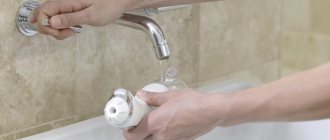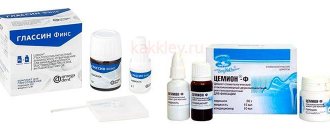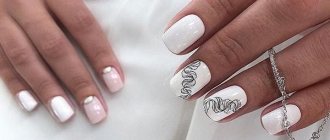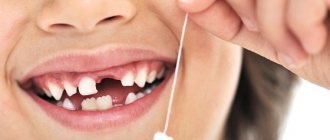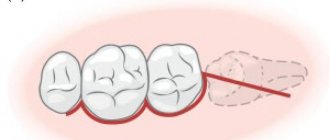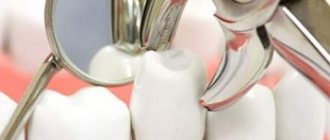Requirements for dressing material in dentistry
After tooth extraction, the dentist gives each patient simple but significant recommendations, compliance with which will promote rapid healing of the wound and reconstruction of damaged tissue.
One of the following recommendations is not to remove the gauze swab that the surgeon placed there from the hole for a certain period of time. This tampon acts as a compress, compressing the edges of the hole and absorbing blood.
Tooth removal is a surgical intervention, albeit in a minimal area. Any operation is not complete without compromising the integrity of the tissue, which inevitably results in bleeding.
The surgeon places a sterile gauze pad on the site of the extracted tooth to stop capillary bleeding.
A blood clot begins to form under the tampon, which will protect the wound from the penetration of pathogens.
Important! If the operation was not severe (for example, a loose tooth was removed), and the hole literally does not bleed, there is no need to apply a tampon. This also happens in cases where blood clotting factors lead to the rapid formation of a clot.
The operation does not always go smoothly.
In some cases (for example, after the removal of a wisdom tooth), the area of damaged tissue is very large and the wound is deep, and in this case a regular gauze swab will not cope with heavy bleeding. In these cases, the dentist can use iodoform turunda. It is gauze soaked in a disinfectant solution and folded in a special way.
Reference! Iodoform is a substance obtained from ethanol or acetone. Widely used in surgery as an antiseptic.
The turunda is placed in the hole, folded from one edge to the other, and pressed tightly. The medical worker places a gauze pad over the turunda and asks the patient to squeeze it with his teeth for 15-30 minutes to make sure there is no bleeding. If blood does not ooze through the turunda, the patient is released into housing.
Photo 1. Gauze, twisted into a tourniquet and soaked in an antiseptic, with a number of means to achieve the goal for placing it in the hole.
The gauze swab must be kept in the mouth for no longer than half an hour. If you leave it for much longer, it may dry to the wound, in which case you will have to soak it with chlorhexidine. This may help prevent the wound from becoming infected, but there is a high risk of not removing the formed blood clot.
Important! A gauze swab soaked in blood and saliva is a nutrient medium for the reproduction and constructive activity of bacteria. This is another reason not to keep a tampon in your mouth for more than 20-30 minutes.
As for iodoform turunda, it can be removed no earlier than after 5-6 days, when the healing process of injured tissue begins. Premature exclusion is highly likely to provoke secondary bleeding.
To avoid complications such as wound infection and promote its healing, you should follow a number of recommendations:
- Stop drinking and smoking alcohol until complete healing; exclude from the diet foods that are too harsh, sour, feverish and unforgiving; Do not allow the wound to warm up, do not apply spiritual compresses, do not visit baths and saunas; Postpone sports activities and try to get by without physical fatigue; Don’t forget about oral hygiene, but brush your teeth with increased precautions; Use all medications prescribed by a medical professional strictly according to instructions.
Required video
Watch the video in which a medical professional explains in detail what it is necessary to perform a tooth extraction.
To stop bleeding, a pressure bandage must be applied to the various wounds found. In the case of a wound at the site of an extracted tooth, this function is performed by a sterile gauze swab or iodoform turunda.
The doctor begins treatment by washing the socket and treating it with antiseptic solutions, and then cleans the socket from the remains of the blood clot using a surgical curette. Then the wound is dried with a gauze swab and treated with an anesthetic and antibacterial agents. The wound is covered with a bandage, which is designed to protect the open surface of the wound from possible biological, chemical or mechanical irritants. To check the possibility of detecting pieces of the extracted tooth in the socket, an x-ray can first be taken.
The procedure for cleaning the hole as a whole is carried out according to the following scheme:
- Local anesthesia is performed;
- The well is washed with an antiseptic solution (hydrogen peroxide solution 3%, chlorhexidine 0.05% or furatsilin 0.02%), and food debris and necrotic masses are removed;
- If there are foreign bodies in the hole (root fragments, cysts and granulomas), they are removed using special instruments;
- After cleaning the hole, it is treated with antiseptic solutions, dried with a sterile gauze swab, and turunda with an antiseptic and an anesthetic is injected into it. With a mild degree of inflammation, a turunda may not be necessary; thorough cleansing of the hole and subsequent care for it is sufficient;
- In case of a pronounced necrotic process in the hole, rinsing and application with trypsin is carried out - this is an enzyme preparation that accelerates the breakdown of dead tissue. Trypsin has anti-inflammatory and anti-edematous effects, helps clean the socket from necrotic masses and pus;
- After completing all the manipulations, the patient goes home, the doctor appoints appointment days when he needs to come for antiseptic treatment of the hole and change the turunda, if one has been installed. If necessary, a course of antibiotics is prescribed.
For alveolitis, antiseptic baths (not rinsing) with solutions of chlorhexidine 0.05% or miramistin 0.01%, which can be purchased ready-made at the pharmacy, are effective. When performing baths, the solution is taken into the mouth and held for several minutes, then carefully spat out. To relieve pain and reduce the degree of inflammation, nimesulide or ibuprofen are prescribed.
To prevent the turunda from falling out of the socket, during treatment you need to eat soft, pureed food and do not chew on the sore side. If the turunda does fall out, you need to rinse your mouth with chlorhexidine solution and immediately consult a doctor.
If this is not possible, you should rinse the hole yourself from food debris: to do this, bite off the sharp tip of the needle from a 5 ml syringe, bend it a little, and disinfect it with pure alcohol. A chlorhexidine solution is drawn into the syringe, the needle is inserted into the hole (not too deep) and the piston is pressed intensely to create a liquid pressure that can remove food debris.
All cases of alveolitis treatment are individual, so it may be necessary to visit the dentist up to several times.
With a favorable course of the healing process, the pain goes away, and the inflammatory process gradually subsides and disappears after a few days.
If the process, despite the procedures performed, progresses, then after antiseptics, gauze tampons soaked in propolis tincture or camvorophenol solution (10%) are inserted into the hole. A tetracycline-prednisolone cone inserted into the well has a good antibacterial effect.
The main criteria for assessing the quality of dental dressings are:
- compatibility with medications applied to the bandage;
- resistance to oral microflora;
- possessing sufficiently high organoleptic properties - acceptable odor and appearance.
We invite you to familiarize yourself with the Types of anesthesia in dentistry, indications and contraindications for local anesthesia.
The following are widely used in dentistry:
- Absorbent cotton wool is used in therapeutic dentistry to dry the patient’s oral cavity during treatment. Cotton rolls are formed by twisting the material onto the handle of any dental instrument.
- White gauze is used to make napkins, balls, and strips for tamponade. The main condition is that the edges of the gauze are folded into the middle - this prevents fibers from getting into the wound. Used as a drying material for wounds.
The dressing material must be sterilized before use.
Gum dressings are composed of:
- soft - ointments, gels (actovegin, solcoseryl) - applied in a thin layer to the wound surface. This category includes bandages made of cotton wool, gauze, bandages;
- semi-solid - are made by applying a mixture of dentin paste and ointment to the prepared tissue surface. The bandage is applied to the wound and fixed by compressing the teeth. After 6 - 7 minutes it hardens and is securely attached to the desired area;
- solid - septopack (ready-made product) or independently prepared using dentol, repin. The components have a high degree of biological compatibility with the mucous membrane, their use significantly accelerates the wound healing process;
- collagen films – have anesthetic and antiseptic properties, promote rapid regeneration of soft tissues of the oral cavity;
- adhesive - are non-toxic compositions based on polyurethane. Once on the mucous membrane, the material polymerizes, creating a plastic, porous film.
Dressings are prescribed for the following indications:
- after surgery – when there is a need to protect the wound surface from the effects of the external environment or to protect the mucous membrane from damage by suture material (monofilament);
- for medicinal purposes - periodontal dressings help to increase the effectiveness of the treatment provided, protecting the drugs introduced into the periodontal pockets from being washed out by saliva, and contribute to their prolonged action;
- tamponade – used after tooth extraction to prevent bleeding. Iodoform gauze turunda is made from a strip of gauze soaked in a special solution that has an antiseptic effect on the wound.
The main rule should be noted - the presence of a strong inflammatory process and the release of purulent exudate from the wound is a direct contraindication for applying bandages.
Depending on the properties and purposes, the duration of wearing the bandage is determined:
- with a therapeutic effect - from 2-3 hours to 3-4 days. They mainly use gauze and bandages, applying the necessary drugs that have antimicrobial and anti-inflammatory properties to them;
- for protection purposes, adhesive, semi-solid and hard dressings are often used, capable of fixing the application for 4-7 days;
- collagen films – have the possibility of the longest rehabilitation period (up to 20 days). Can be used as a bandage after surgery and as an independent treatment for bedsores from dentures.
Turunda with iodoform
Turunda in dentistry is a piece of gauze that is soaked in iodoform. This is an antiseptic substance that has a characteristic odor and taste. Iodoform is yellow in color, so the impregnated materials have a light yellow tint.
Also called turundas are cotton or gauze swabs that are temporarily placed with a medicinal substance in the tooth socket.
Turunda is used in different cases, but its main tasks are as follows:
- stop bleeding;
- accelerate wound healing in the hole;
- minimize drying out of the hole;
- prevent the growth of bacteria in the hole;
- for abscesses - to remove pus.
If bleeding does not stop for a long time after tooth extraction, then installing a tampon with medicine is a mandatory process.
After the doctor finishes removing the tooth, the gums will bleed. This is normal and the bleeding usually stops after a few minutes.
But there are exceptions to any rule, and it often happens that the bleeding does not stop on its own.
In cases where blood comes from deep within the socket, iodoform turunda is used. The effect of its hemostatic use is achieved due to its compaction and blocking the possibility of blood flow.
In addition to the hemostatic effect, turunda, due to the presence of iodoform, has disinfectant properties.
Also, in some cases, iodoform turunda can be used for drainage of the periapical region for the purpose of outflow of inflammatory products.
In what cases should you consult a doctor?
Here are the most common ones:
- a person’s temperature has risen sharply to very high levels (although a slight increase in temperature is normal);
- the person suffers from very severe pain that even painkillers cannot relieve;
- the clot has been rejected from the socket;
- the hole smells unpleasant for a long time;
- a blood clot does not form in the socket;
- bleeding began;
- strange sensations arose (for example, as if a tooth had grown, etc.).
It is also very important to remember to visit your dentist to remove the sutures. However, the doctor must warn the client about this in advance: if he uses self-absorbing sutures, then there is no need for a repeat visit. But if the doctor uses sutures that do not dissolve on their own, you must remember to remove them. This procedure is completely painless.
There are many symptoms indicating the development of complications. First, let's look at what is considered normal:
- Bleeding that may last for days. At first (up to half an hour), bleeding may be profuse, then it should decrease. It may stop completely, or blood may ooze out slightly, coloring the saliva.
- Pain in the socket. After taking the painkiller, the pain will go away. After a while it may return, but it will no longer be as intense.
- The occurrence of swelling, which can cause discomfort and limit the free opening of the mouth.
If complications develop, immediate doctor intervention is required. The following signs may indicate that not everything is in order:
- heavy, continuous bleeding for more than 2 hours;
- swelling that occurred on the third day after surgery;
- spread of swelling to the outside of the face;
- shooting pain in the socket, increasing day by day;
- bad breath due to the absence of a clot;
- heat.
How long should the turunda be kept in the socket after tooth extraction?
To avoid complications such as infection of the wound and promote its healing, you should follow a number of recommendations:
- stop smoking and drinking alcohol until complete healing;
- exclude too spicy, sour, hard and hot foods from the diet;
- do not allow the wound to warm up, do not apply warm compresses, do not visit baths and saunas;
- postpone sports activities and try to do without physical fatigue;
- do not forget about oral hygiene, but brush your teeth with extreme caution;
- Use strictly according to the instructions all medications prescribed by your doctor.
After the operation, the doctor does not release the patient immediately, but asks him not to leave for 15-20 minutes to make sure that everything is in order. The tampon should be kept in the mouth during this entire time and removed after 20-30 minutes.
If any problems arise (blood clotting disorders, arterial hypertension), the bandage can be removed only after an hour.
In any case, it is better to remove the tampon later than the specified time than to do it earlier, otherwise bleeding may resume.
General overview
Turunda in dentistry is a piece of gauze that is soaked in iodoform. This is an antiseptic substance that has a characteristic odor and taste. Iodoform is yellow in color, so the impregnated materials have a light yellow tint.
Also called turundas are cotton or gauze swabs that are temporarily placed with a medicinal substance in the tooth socket.
Turunda is used in different cases, but its main tasks are as follows:
- stop bleeding;
- accelerate wound healing in the hole;
- minimize drying out of the hole;
- prevent the growth of bacteria in the hole;
- for abscesses - to remove pus.
If bleeding does not stop for a long time after tooth extraction, then installing a tampon with medicine is a mandatory process.
Reviews
Should I use turunda after tooth extraction or not? The answer must be given exclusively by a competent dentist. The use of these devices has a number of its own indications.
Scientific achievements do not stand still, and many modern experts talk about the irrationality of using turundas. The reason for such statements is that the effects of iodoform wear off after a few hours. Afterwards, it is washed out from the gauze pad, and a foreign object in the hole will likely lead to infection. In addition to ancient methods, the use of ultra-modern medical drugs is recommended.
Procedures for continuing treatment at home
Treatment of alveolitis at home is carried out when acute symptoms have been eliminated, antiseptic turundas are no longer needed and the goal is to speed up the healing of the hole. For this use:
- Mouth rinses with infusions of chamomile, calendula, and sage. These medicinal plants have anti-inflammatory properties and accelerate healing processes. Rinsing is carried out several times during the day, always after meals.
- Applications with dental adhesive paste Solcoseryl. The drug belongs to the group of tissue regeneration stimulators: it accelerates healing, improves the supply of cells with oxygen and nutrients. The paste has a pleasant mint taste and contains the anesthetic component polidocanol 600. To properly apply the paste, you need to dry the hole with a gauze swab and fill it with Solcoseryl, lightly moisten the paste with water on top. The procedure is repeated several times a day as necessary; the paste is able to protect the socket throughout the day from mechanical and chemical influences.
- Taking vitamin preparations. You can purchase any vitamin and mineral complex at the pharmacy (Vitrum, Duovit, Complivit); Vitamins are taken to increase the body's defenses and shorten the recovery period.
Additional physiotherapy treatment (click to expand)
Physiotherapeutic treatment is an important addition to drug therapy; with the help of physiotherapy, the intensity of inflammation can be significantly reduced and healing time can be accelerated. For alveolitis, the following techniques are used:
- UV therapy - the hole is irradiated with short-wave ultraviolet light, which kills pathogenic microorganisms and reduces the level of inflammation.
- SMV therapy is a method of treatment with an electromagnetic field, based on the effect of centimeter waves on the area of inflammation. The procedure helps improve blood circulation and metabolism, due to which toxic substances are removed from tissues faster and regeneration processes are accelerated. SMV therapy also has an analgesic effect.
- UHF therapy – the body is exposed to a high-frequency electromagnetic field. For alveolitis, UHF therapy is used if the patient's regional lymph nodes are enlarged.
- Electrophoresis – medications are injected into inflamed tissue using electrical impulses. For post-extraction alveolitis, electrophoresis is used to reduce pain. For this purpose, solutions of novocaine, lidocaine, trimecaine are used.
- Fluctuarization is a treatment technique with pulsed currents of a sinusoidal shape with a low frequency. As a result of the procedure, blood circulation and lymph flow improves, swelling resolves, and the level of inflammation decreases.
- Laser therapy - the hole is exposed to infrared laser radiation, which has an anti-inflammatory effect, reduces swelling and redness of soft tissues, and accelerates healing.
Manufacturing
To make turunda for dental purposes, you need to know the proportions of dilution of iodoform, since this substance has a crystalline structure. Iodoform does not mix well with ordinary water. Therefore, it practically does not dissolve.
Medical ether is used to fill wounds after tooth extraction. The main thing is to maintain the proportion - 1 part iodoform to 10 parts ether.
It is not recommended to store the prepared solution, as it loses its properties. It is important to prepare the exact amount of soluble iodoform for one or more turundas.
For the turunda itself, cut out a small gauze ribbon. Its length can be different, because it all depends on the depth and width of the hole. The finished piece is impregnated with the composition.
The purpose of using turunda after tooth extraction. Iodex in dentistry: instructions, paste
Turunda in dentistry is a piece of gauze that is soaked in iodoform. This is an antiseptic substance that has a characteristic odor and taste. Iodoform is yellow in color, so the impregnated materials have a light yellow tint.
Also called turundas are cotton or gauze swabs that are temporarily placed with a medicinal substance in the tooth socket.
Turunda is used in different cases, but its main tasks are as follows:
- stop bleeding;
- accelerate wound healing in the hole;
- minimize drying out of the hole;
- prevent the growth of bacteria in the hole;
- for abscesses - to remove pus.
If bleeding does not stop for a long time after tooth extraction, then installing a tampon with medicine is a mandatory process.
Directions for use and doses
The antiseptic is used in the treatment of lymphadenitis, phlegmon, dermatitis in a mixture with petroleum jelly in a concentration of 5–10% iodoform.
To treat burns with bacterial contamination, wounds with pockets and cavities, an iodoform solution is used. The antiseptic is diluted in medical ether in a ratio of 1 to 10. The solution cannot be stored. It should be diluted in the amount necessary to fill all fistulas, cavities, and pockets.
Biological properties
The biological effect of the drug, in general, is equal to the effect of each of its individual components:
- iodine - activated under the influence of tissue exudate and atmospheric oxygen and has an antiseptic effect. Plus, thanks to its ability to form iodamines - stable compounds with proteins - it dries the wound and helps relieve swelling;
- streptocide is a proven antimicrobial agent. Some strains of microorganisms have developed resistance to the drug, but the drug still remains effective against gono-, meningos-streptococci and pneumococci, as well as E. coli;
- zinc - dries the wound, and its ions are necessary for the full synthesis of collagen protein.
Side effects
The antiseptic does not cause any significant side effects. In very rare cases, the use of Iodoform can lead to the development of iodism, which is characterized by inflammation of the mucous membranes in areas of iodine secretion - in the respiratory tract, paranasal sinuses, salivary glands, etc. The main symptoms of iodism are:
- Swelling of the mucous membranes, increased salivation, lacrimation, bronchorrhea (excessive secretion of mucous sputum during coughing), rhinorrhea (excessive amount of exudate from the mucous layer of the nasal cavity).
- Damage to the mucous membranes, characterized by rhinitis (inflammatory process of the nasal mucosa), conjunctivitis (inflammation of the mucous membrane of the eyes), bronchitis (inflammatory disease of the bronchi), tracheitis (inflammatory process of the mucous layer of the trachea), laryngitis (inflammation of the ligaments and mucous membrane of the larynx).
- Digestive disorder.
- Rashes on the skin of the face and body in the form of iodine acne.
If adverse reactions occur, Iodoform must be immediately replaced with another iodine-containing agent or temporarily discontinued.
Indications
The instructions for Iodoform recommend the use of the above remedy as an antiseptic drug in the treatment of ulcers and infected wounds of various etiologies.
In dentistry, this antiseptic is used as an anesthetic during the treatment of various wounds. In addition, the use of Iodoform as a temporary canal filler in the treatment of root canals and intracanal filler in endodontic treatment in combination with other medications promotes an antiseptic effect.
Prevention of stroke in old age
How to beat insomnia
Why do joints hurt?
Manufacturing
To make turunda for dental purposes, you need to know the proportions of dilution of iodoform, since this substance has a crystalline structure. Iodoform does not mix well with ordinary water. Therefore, it practically does not dissolve.
Medical ether is used to fill wounds after tooth extraction. The main thing is to maintain the proportion - 1 part iodoform to 10 parts ether.
It is not recommended to store the prepared solution, as it loses its properties. It is important to prepare the exact amount of soluble iodoform for one or more turundas.
For the turunda itself, cut out a small gauze ribbon. Its length can be different, because it all depends on the depth and width of the hole. The finished piece is impregnated with the composition.
How popular is the service of teeth removal at home, and what patients should know about the procedure.
Source: https://probol.info/stomatologiya/tsel-ispolzovaniya-turundy-posle-udaleniya-zuba-jodeks-v-stomatologii-instruktsiya-pasta.html
Rules of application
The principle of use itself is quite simple. If we are talking about a tooth socket after tooth extraction, then the turunda is pre-twisted in the form of a tourniquet.
It is important that it completely reaches the bottom of the hole. If there is free space left in the hole, then this is dangerous due to the development of inflammation due to the active proliferation of bacteria in the blood clot. Installation algorithm:
- A thorough examination of the hole. There should be no bone fragments left in it, because this can cause pus and inflammation.
- Turunda is introduced into the cleaned hole so that it “sits” tightly over the entire area.
- Once it is fully seated, the patient should bite down on it well to ensure that any remaining voids are filled.
After installation, the doctor must indicate the exact time at which the gauze cannot be removed. In case of inflammatory processes, medications can also be placed in the hole along with soaked gauze. In this case, you cannot remove the turunda for 1-2 weeks, but it all depends on the situation.
If the tooth extraction was successful, then the hole is simply “closed” with a sterile gauze swab. It can be removed after 20-30 minutes.
We invite you to familiarize yourself with White balls on the tonsils, what are they?
If you keep such a tampon for more than the specified time, it will become a real provocateur for the growth of bacteria. In addition, it will prevent the formation of a clot.
After removal, it is important to follow all doctor's recommendations. It is important to ensure that re-bleeding does not occur. This often happens if the patient is taking blood thinning drugs.
What do they put in the hole after removal: a tampon or cotton wool?
Tooth extraction is a surgical intervention, albeit in a small area. Any operation is not complete without violating the integrity of tissues , which inevitably entails bleeding. The surgeon places a sterile gauze pad on the site of the extracted tooth to stop capillary bleeding . A blood clot begins to form under the tampon, which will protect the wound from the penetration of pathogens.
Important! If the operation was easy (for example, a loose tooth was removed), and the hole practically does not bleed, there is no need to apply a tampon . This also happens when blood clotting factors lead to rapid clot formation.
This is interesting: What antibiotics to take after tooth extraction, rules of administration
What is a tampon and why is it used?
The tampon, which the dentist places on the site of the extracted tooth, is made from several layers of bandage or gauze rolled up.
Sometimes for this purpose they use ready-made turundas impregnated with an iodoform composition, which has powerful antiseptic properties. Dentists almost never use cotton wool, since its small fibers can get into the wound and cause inflammation. Sometimes cotton fiber is used as the base of a tampon. The main purpose of the tampon is to stop the bleeding, which can be a lot, because the depth and volume of the wound are quite large, especially if a molar with three roots has been removed. Due to damage to a significant number of vessels, alveolar bleeding begins. Although this phenomenon is completely normal - the red liquid prevents the occurrence of an inflammatory process in the hole, since it has bactericidal properties - the bleeding should still be stopped to avoid blood loss.
Tamponing helps seal the vessels while the body copes with the problem. If the patient presses the bandage well with his teeth, the bleeding will stop faster. The blood flowing from the wound gradually coagulates (coagulates) and a clot forms at the site of tooth extraction. It is important that it covers the hole for as long as possible, preventing infection.
If the bleeding does not stop, the doctor may use iodoform turunda. It is placed on the bottom of the hole from edge to edge, pressing carefully. If the tooth had several roots, then turundas are laid in each move. Sometimes the doctor puts stitches on top to prevent the gauze from falling out of the wound prematurely. Next, the doctor places a folded bandage or tampon on the gum and asks the patient to press it with his teeth.
Not all dentists share the opinion about the need to use turunda. It is known that the antiseptic (iodoform) is washed out of the bandage within a few hours, after which the bandage becomes a breeding ground for infection.
Fortunately, today there are special drugs that help stop bleeding and remove inflammation without the use of turunda, for example, “Neoconus” or the self-absorbing sponge “Alvostaz”.
Why use a dental sponge?
The product is used to put into a wound and has the following effects:
- Stops bleeding.
- Protects the wound from infection and infection.
- Reduces pain.
- Relieves swelling of the gums.
- Accelerates the healing of damaged tissues.
The hemostatic sponge is used strictly as prescribed by the doctor , taking into account contraindications and possible side effects. It is important to follow the instructions for use to minimize the risk of complications.
Important! Before use , the dentist must find out whether the patient is allergic to medications in order to avoid adverse reactions.
Complications of alveolitis
If alveolitis is not treated in a timely manner, the following complications may develop:
- Odontogenic sinusitis is an inflammation of the maxillary sinus caused by the spread of infection from the inflamed sockets after the removal of premolars or molars of the upper jaw;
- Phlegmon - purulent inflammation spreads to the surrounding soft tissues;
- Acute periostitis - pus accumulates in the periosteum area;
- Odontogenic osteomyelitis is a purulent-necrotic lesion of the jaw bone;
- Sepsis - an infection enters the bloodstream, causing it to become infected.
Alveolitis itself is not so dangerous, but its complications are life-threatening. Therefore, if you notice symptoms of alveolitis, contact your doctor immediately.
Contraindications
There are no absolute contraindications for use, but it is important to know whether the patient has an allergic reaction to iodoform.
To check, just apply a small amount of the diluted composition to the skin of your elbow or wrist. If no redness, itching or rash occurs after application, then using iodoform is completely safe.
If the patient is allergic to this substance, then it needs to be replaced, or simply use a sterile bandage.
The patient's role in the prevention of alveolitis
Prevention of alveolitis consists of following the recommendations of the attending physician after tooth extraction; it is obvious that in the matter of prevention, a large role is assigned to the patient; it depends on his actions how quickly and without consequences the healing of the hole will take place. The role of the doctor is to perform the operation in accordance with the standards of care and communicate recommendations to the patient.
According to statistics, in most cases, the cause of the development of post-extraction alveolitis is the patient’s incorrect actions after tooth extraction, ignoring the recommendations of the attending physician. After tooth extraction it is prohibited:
- Remove the blood clot from the socket. The blood clot that forms in the hole after tooth extraction prevents microbes from entering the wound, and the healing process under it proceeds quickly and without complications. Patients can remove the clot by touching it with the tongue, with fingers, by vigorously rinsing the mouth immediately after tooth extraction, and also while eating solid foods.
- Do hard physical work, sports, take hot baths, go to the sauna. Intense loads and elevated temperatures provoke the opening of the wound, and bleeding resumes; pathogenic microorganisms can enter the wound.
- Smoking, drinking alcohol. Bad habits lead to excessive irritation of the mucous membranes, healing of the hole is much slower, and inflammation may occur.
To speed up healing and prevent the development of inflammation in the socket, you need to:
- In the first few days after tooth extraction, review your menu, excluding spicy, too salty, sour, and hot dishes. All food should be soft, pre-chopped;
- Maintain careful oral hygiene. The presence of chronic inflammation of the gums and carious teeth in the mouth can cause infection of the socket, so after tooth extraction you need to carry out antiseptic baths (they should be prescribed by a doctor);
- After each meal, rinse your mouth with clean water to remove any remaining food; this must be done very carefully so as not to remove the blood clot covering the hole;
- Brush your teeth carefully, trying not to touch the socket with the brush.
Actions of the dental surgeon to exclude alveolitis:
- Thoroughly clean the socket so as not to leave a tooth fragment or cyst in it. After extracting a tooth, especially a damaged one, a control x-ray of the socket is often taken;
- Be careful and avoid injury. The tooth extraction was accompanied by bone injury due to the inept actions of the doctor. Usually the bone is injured during complex extraction, when tooth extraction cannot be carried out using conventional instruments. Difficult procedures include the removal of unerupted and incorrectly positioned wisdom teeth, multi-rooted teeth, and teeth with curved or destroyed roots. An inexperienced doctor may not understand the situation and damage the bone;
- Control during anesthesia. An overdose of anesthetic leads to a sharp decrease in the amount of blood released after tooth extraction and insufficient formation of a blood clot;
- Prescribing appropriate antibacterial drugs, especially if the tooth extraction was difficult or was carried out against the background of purulent inflammation.
Therefore, it is very important to seek help from competent and experienced specialists who are fully familiar with all the intricacies of the tooth extraction procedure.
Sometimes alveolitis can develop despite preventive measures taken due to certain reasons. These reasons include:
- Reduced immunity of the patient, inability of tissues to regenerate;
- Tendency to bleed, resulting in a blood clot not forming;
- An increase in the amount of the hormone estrogen in women when taking hormonal contraceptives or certain diseases, which leads to the destruction of a blood clot.
A timely visit to the dentist if alveolitis develops is the key to a quick cure. Patients of our clinic who have undergone tooth extraction surgery receive detailed recommendations on oral care; if they are strictly followed, the likelihood of developing alveolitis is excluded.
How long does it take for a hole to heal?
The wound left after tooth extraction has a certain healing pattern.
- After the tooth extraction procedure is completed, the circular ligament located around the crown of the extracted tooth begins to contract.
- A short amount of time after the procedure, you may notice an accumulation of blood in the hole. The resulting clot helps protect the wound from infection or small food particles. Over time, the hole begins to become overgrown with fibrous tissue.
- After a certain amount of time, which depends on the characteristics of the human body, as well as on the correct care of the hole after the procedure, the surface of the wound heals and the affected area of the gum is restored.
- After this, over time, new epithelium grows on the surface of the gum, as well as the development of bone tissue at the site of tooth extraction.
This is interesting: Teeth removal surgery at home
Many patients worry about the healing of the wound that remains after tooth extraction. The doctor must explain to the patient that the wound can heal completely only after two or three weeks, provided that all care rules are followed. If they were nevertheless broken or an infection was still able to penetrate the wound, then with repeated disinfection, complete restoration of the affected area will occur in five months.
What is allowed during the healing period?
- Non-solid semi-liquid food.
- Gentle oral hygiene.
What is prohibited during the healing period?
- Drinking alcohol and smoking cigarettes.
- Drinking liquids with a plastic straw.
- Harsh brushing of teeth in general and especially in the healing area.
- Eating dry and solid food.
- Sudden movements of the cheekbones for one week after the procedure.
Auxiliary medications for tooth extraction
If, after the tooth is removed, any complications begin at the intervention site, then modern pharmaceuticals can cope with them. With the help of various medications, the patient can not only eliminate the resulting secondary complications, but also strengthen his immunity as a whole. Quite often, specialists, to ensure against possible complications, in particular, various inflammations and suppurations, prescribe antibacterial drugs in the postoperative period. At the same time, the patient also needs to strengthen the immune system, which will help the wound heal faster. To do this, doctors prescribe vitamin complexes to the patient. Thus, in addition to the medicine placed in the hole and affecting its healing, the patient is recommended to take other drugs to speed up the process.
If during the procedure the patient was identified with any peculiarities or complications and tooth extraction was not without additional trauma, then a number of medications are prescribed in the postoperative period, since in this case there are additional risks of complications. The main thing is that the patient treats the postoperative period responsibly and does not neglect the doctor’s advice and the medications prescribed to him.
Important! According to statistics, every third patient who has had a tooth removed needs to take antibiotics.
Taking antibiotics after the procedure
Dentists quite often resort to antibiotics in the postoperative period, especially after tooth extraction. But not every patient who has undergone tooth extraction requires antibiotics. They are prescribed only in the following cases:
- if the patient experiences inflammatory processes in the gum area;
- if the patient is elderly;
- if complications arise during the operation or features of the anatomy of the teeth are revealed, which contributes to more extensive trauma;
- if the patient has a reduced immune system or suffers from any blood diseases.
This list is not all the reasons for prescribing antibiotics in the postoperative period, because each individual case has its own characteristics. An experienced dentist will be able to easily determine which patient needs to take medications after tooth extraction. The doctor must determine the duration of administration and dose individually for each case. Most often, the course of taking the drug after tooth extraction lasts from five to seven days. In rare complicated cases, treatment can last up to fifteen days. It is simply impossible to determine the average dose of antibiotics that is needed, since each individual drug has its own individual characteristics.
Important! It is strongly recommended not to take antibiotics unless prescribed by a doctor.
In addition to antibiotics, your doctor may also prescribe medications to normalize the microflora after taking antibiotics. The most commonly prescribed drug is Linex, but sometimes other drugs from the group of probiotics are also prescribed.
What vitamin complexes are prescribed after tooth extraction?
Experts recommend taking a vitamin course during the wound healing period after tooth extraction. Experts have proven that additional intake of a vitamin course can help speed up the healing process, as well as several times reduce the risk of complications after surgery, especially suppuration.
What painkillers can be taken in the postoperative period?
Most often, when local anesthesia wears off after a tooth extraction procedure, the patient feels pain in the area of intervention. The best way to eliminate pain is to take NSAIDs. This group of drugs is the most effective in eliminating toothache.
- The drugs "Nurofen" or "Ibuprofen" cope well with pain after surgery. It is necessary to take the drug 500-800 mg three to four times a day, depending on the intensity of the pain.
- "Ketorol" is one of the most effective and powerful drugs from the NSAID group, which can eliminate pain after the procedure in a fairly short time. It is also used two tablets three to four times throughout the day.
Features and shelf life
Store ready-made cotton balls or gauze strips in an extremely sterile environment. They can be stored along with bandages and napkins. The ideal storage place would be a sterile container, but it is still not entirely reliable, as it often opens.
For convenience, dentists pack tampons and turundas in separate paper bags, which must be sterilized in an autoclave.
It is appropriate to sterilize immediately before using the material, since over time, bacteria can get on cotton wool, bandages or gauze. The shelf life of sterilized turunda is on average 7 days.
The video provides additional information on the topic of the article.
Iodoform turunda after tooth extraction when it is removed
- When the question arises about tooth extraction, the patient is interested in knowing what the doctor is doing and whether everything is in order.
- Asking questions with your mouth open is inconvenient, and it is impossible to predict the doctor’s actions in advance.
- Most specialists do not consider it necessary to educate the patient about the intricacies of the work.
- In this article we will try to clearly explain one of the ways to stop bleeding after tooth extraction.
General overview
After the doctor finishes removing the tooth, the gums will bleed. This is normal and the bleeding usually stops after a few minutes.
But there are exceptions to any rule, and it often happens that the bleeding does not stop on its own.
In cases where blood comes from deep within the socket, iodoform turunda is used. The effect of its hemostatic use is achieved due to its compaction and blocking the possibility of blood flow.
In addition to the hemostatic effect, turunda, due to the presence of iodoform, has disinfectant properties.
We invite you to familiarize yourself with a pin in a tooth: what it is, how it is used in dentistry
Also, in some cases, iodoform turunda can be used for drainage of the periapical region for the purpose of outflow of inflammatory products.
Manufacturing
Iodoform turunda is made from sterile gauze and soaked in a special solution. Components of the impregnation solution:
- iodoform – 50 parts;
- ether – 70 parts;
- ethyl alcohol – 30 parts;
- glycerin – 15 parts.
A strip of sterile gauze 10-15 mm wide is immersed in a pre-prepared solution. After this, the gauze is pulled out and left to dry. When the ether evaporates, the gauze turns bright yellow and is ready for use.
You can also buy an iodoform bandage at a pharmacy. For ease of storage, it is sold in cans and has a width of 20-25 mm and a length of up to 5 meters.
Rules of application
The process of stopping bleeding begins with removing any remaining blood clots from the socket. The field is treated with saline or chlorhexidine solution and dried with cotton swabs.
Then the hole is filled with turunda, starting from the very bottom. In the process of filling the hole, the turunda is folded from one edge to the other and pressed tightly.
In cases where a tooth with several roots was removed, each hole is filled separately. To prevent the turunda from falling out, the edges of the wound are pressed against each other, placing sutures at a distance of 5-7 mm from the edge of the gum.
If there is no bleeding, the gauze pad is removed and the patient can go home. If the bleeding is not stopped, the packing procedure is repeated.
The turunda is removed 5-6 days after the healing process of the gum walls begins. If you remove it earlier, re-bleeding is possible.
Typically, healing of the hole occurs according to the following scenario:
- On days 3-4, granulation tissue begins to develop. White crusts on this tissue are newly formed epithelium. It is highly undesirable to damage it in any way.
- After 14 days, the hole is completely overgrown with granulation tissue. The formation of bone tissue begins on the bottom and side walls.
- After 45 days, bone tissue fills the socket.
- From 45 to 90 days, bone tissue is transformed into mature bone.
- 4-6 months. The gum is completely healed, and on x-ray the bone tissue is indistinguishable from the entire jawbone.
Contraindications
- As such, there are no contraindications to the use of this method of stopping bleeding, with the exception of hypersensitivity to iodoform.
- However, science does not stand still and more and more experts are inclined to conclude that the use of turunda is irrational due to the fact that the effect of iodoform ceases after a few hours.
- It is then washed out of the gauze, and a foreign object in the hole can lead to infection.
Instead of outdated methods, the use of modern medications is proposed.
Removal of a tooth is accompanied by injury to the mucous membrane and bone in which it was located. But if the removal was easy and the patient follows the doctor’s instructions, then the wound will heal on its own. An important condition for rapid healing of the bone at the site of the tooth is the appearance and preservation of a blood clot, which:
- prevents infection from entering the wound;
- is the basis for the appearance of a bone scar at the site of an extracted tooth;
- blood has a local protective effect because it contains antibodies and cells of the immune system.
It is important that a blood clot forms without sources for its infection, which leads to inflammation of the tooth socket, despite its presence.
Turunda with iodoform are small pieces of gauze that are used for local disinfection of the socket of an extracted tooth. The dentist can place such a turunda immediately after removal if:
- tooth extraction was long and traumatic;
- if an operation was performed to remove a tooth (this is usually how impacted wisdom teeth are removed, which cannot cut through on their own, and at the same time they lie in the bones and other teeth are displaced);
- tooth extraction led to a rupture of the mucous membrane (if the tooth has massive roots and is difficult to remove, or if the broken root needs to be removed with an elevator);
- complications arose during removal (continuation of the maxillary sinus by the root of the tooth, separation of the tubercle of the upper jaw);
- if after removal inflammation of the tooth socket develops - alveolitis.
- A pocket of infection remained in the bone. If the doctor has not inspected the socket, then granulations, cystic sacs, fragments of tooth roots or the interradicular bone septum may remain in it, which become a source of infection or permanently injure the clot.
- The removal was traumatic, and this caused tissue swelling.
- The patient suffers from blood diseases in which blood clotting is impaired (true and pseudohemophilias, Scheinlein-Henoch disease, menstruation (in women), thrombocytopenia, etc.).
- The patient is taking anticoagulant medications due to heart or vascular disease.
- The doctor uses an anesthetic with adrenaline, which causes vasoconstriction and deterioration of blood supply in the socket area.
- The use of painkillers with adrenaline in people with initially narrowed vascular lumen (with hypertension, atherosclerosis, diabetes mellitus).
- Failure to follow the doctor’s recommendations: after removal, the patient rinsed out the clot, drank alcohol, an anti-clotting medicine, did not take into account the recommendations regarding the diet (eats too hot food, chews on the side of the extracted tooth, eats solid food).
Basically, alveolitis occurs in two scenarios:
- According to the “dry socket” type - only the periosteum and mucous membrane of the socket are involved in the process: Serous - there is no discharge or clot in the socket.
- Purulent - accompanied by the appearance of pus from the socket without melting the alveolar bone;
- Ulcerative-necrotic - caused by infection of aggressive flora (fusobacterium and spirillum). Necrotic deposits appear on the surface of the mucous membrane and socket, and when removed, ulcers form. It occurs with an increase in body temperature and severe soreness of the mucous membrane.
What signs indicate the inevitability of removal of a mobile tooth in an adult patient?
The following publication contains detailed information about indications for the removal of baby teeth in children.
Tooth extraction is a procedure that requires an appropriate period of rehabilitation.
One of the most important points is the use of turunda.
It is the installation of a turunda that allows you to stop bleeding and prevent the occurrence of an inflammatory process in the tooth socket.
General overview
Also called turundas are cotton or gauze swabs that are temporarily placed with a medicinal substance in the tooth socket.
Manufacturing
We suggest you read: Pain after wisdom tooth removal, what to do
How popular is the service of teeth removal at home, and what patients should know about the procedure.
Let's talk here about the indications for removing a mobile tooth.
Rules of application
It is important that it completely reaches the bottom of the hole. If there is free space left in the hole, then this is dangerous due to the development of inflammation due to the active proliferation of bacteria in the blood clot.
Contraindications
To check, just apply a small amount of the diluted composition to the skin of your elbow or wrist. If no redness, itching or rash occurs after application, then using iodoform is completely safe.
If the patient is allergic to this substance, then it needs to be replaced, or simply use a sterile bandage.
It is appropriate to sterilize immediately before using the material, since over time, bacteria can get on cotton wool, bandages or gauze. The shelf life of sterilized turunda is on average 7 days.
The video provides additional information on the topic of the article.
Application Details
Instructions
When stopping blood, action should begin with eliminating residual accumulations of blood clots from the socket. All surrounding tissues are treated with saline solution or Chlorhexidine and dried with cotton wool. The turunda is placed in the hole, the beginning is the bottom. While filling the hole, the turunda is wrapped from one edge to the other, pressing well.
When a tooth is extracted, there are several roots, each hole is filled separately. The turunda does not fall out, the edges of the wound are compressed towards each other, sutures are placed at a distance of five to seven millimeters from the edge of the gum. The gauze pad is pressed against the teeth for half an hour, after which the doctor examines the client again. If the blood does not flow, the gauze is removed and the patient is sent home.
If bleeding continues, the packing process is repeated.
The turunda is removed five to six days after the gum walls have begun to heal.
If removed early, it can all start all over again. Basically, healing of the hole occurs in stages.
After three to four days, granulation tissue forms. White crusts are newly formed epithelial tissue. Damaging them is not recommended.
After two weeks, the hole is completely covered with granulation. Bone tissue is formed on the bottom and sides. Forty-five days of bone tissue are needed to fill the hole, up to three months - the bone reaches maturity.
From four to six months is needed for complete recovery. The gums have recovered, and on X-rays the bone tissue cannot be distinguished from the entire jaw.
Contraindications
The only contraindication of its kind is hypersensitivity to iodoform.
To make sure there is no allergy, you need to apply a drop of the diluted composition to the skin surface of the elbow or wrist. In the absence of redness, itching or rash, the use of iodoform will not cause any discomfort. Otherwise, the product is replaced or a simple sterile bandage is used.
Features and shelf life
Storing iodoform turunda is necessary in a tightly screwed jar in a dark and cool place.
If all recommended measures are followed, the shelf life is five years. Even the slightest deviation from the required storage conditions leads to damage to the product. The use of iodoform turunda, which was not stored according to regulations, is prohibited. Dentists, for their own comfort, pack tampons and turunds in separate paper bags, which must be sterilized in an autoclave. It is important to carry out sterilization right before using the product, since after some time, microorganisms will most likely get on it.
The shelf life of sterilized turunda should not exceed a week's shelf life.
